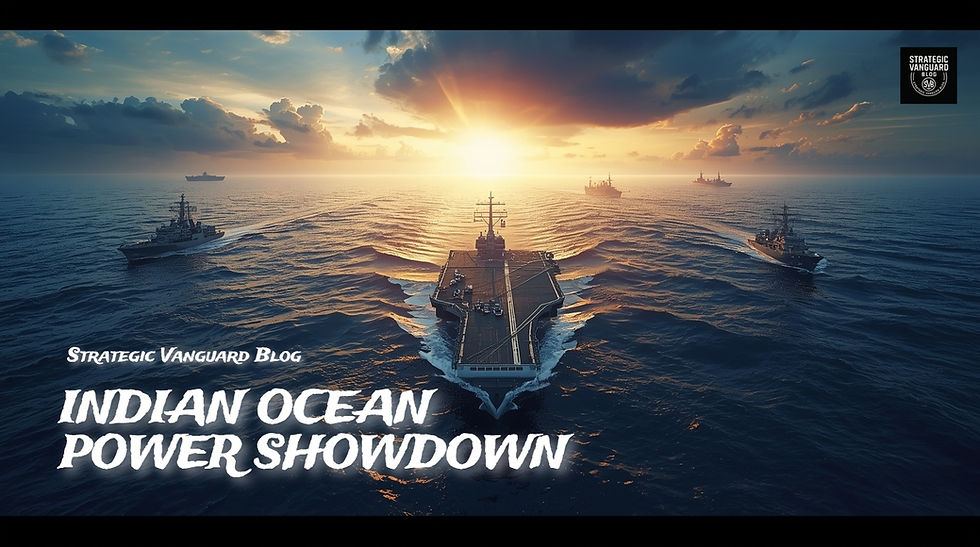India’s Warship Dilemma: Why Nilgiri-Class Frigates Haven’t Replaced Russian Talwar-Class Ships Yet
- Manoj Ambat

- Jul 9
- 3 min read

India is building advanced Nilgiri-class stealth frigates under Project 17A — so why is it still importing Talwar-class warships from Russia? Discover the strategic, technological, and geopolitical reasons behind this dual-track naval strategy.
🛳️ India’s Warship Dilemma: Nilgiri-Class vs Talwar-Class Frigates
India’s naval modernization program is ambitious, strategic, and rooted in national pride. Project 17A — the Nilgiri-class stealth frigates — is a flagship initiative under Make in India, designed to make the Indian Navy self-reliant and technologically advanced.
Yet, even as these powerful indigenous warships are under construction, India has moved ahead with the purchase of Talwar-class frigates from Russia — a class of warships it has been operating for over two decades.
This raises a critical question:
Why is India still buying warships from Russia, when it’s already building its own?
Let’s unpack the layers behind this seemingly paradoxical strategy.
🔧 Project 17A: India’s Next-Gen Stealth Frigates
The Nilgiri-class, part of Project 17A, represents the cutting edge of Indian naval engineering:
Displacement: ~6,700 tons
Armament: BrahMos missiles, Vertical Launch Short-Range Surface-to-Air Missiles (VL-SRSAM)
Radar & Sensors: MF-STAR AESA radar
Design: Advanced stealth shaping, reduced radar signature
Build: Indigenous construction at MDL and GRSE shipyards
These ships are designed to serve as multi-role frontline warships, capable of engaging in anti-air, anti-submarine, and surface warfare operations.
But here’s the catch — they take time to build.
⏳ The Talwar-Class: Bridging the Capability Gap
While the Nilgiris are technologically superior, they are still under construction, and delivery timelines have slipped due to design complexities and integration challenges.
Enter the Talwar-class frigates — modified Krivak III-class warships from Russia. India signed a $2.5 billion deal in 2018 for four new Talwar-class ships — two built in Russia, and two in Goa Shipyard under a technology transfer agreement.
These warships:
Are faster to deliver
Use proven combat systems like Klub missiles and Shtil air defense
Fit seamlessly into India’s existing naval doctrine
Provide interim capability until Nilgiris are fully inducted
This is about bridging a strategic gap, not technological regression.
🌐 Strategic Realism: The Russia Factor
The India-Russia defense relationship is not just about weapons. It’s about trust, strategic balance, and geopolitical flexibility.
India continues to partner with Russia on:
The BrahMos missile program
S-400 air defense systems
Nuclear submarine leases (e.g., INS Chakra)
Spares and upgrades for older Soviet-origin platforms
Buying Talwar-class frigates sustains this long-standing partnership while enabling transfer of shipbuilding know-how to Indian yards like Goa Shipyard.
It’s part of India’s multi-alignment strategy, balancing ties with Russia, the US, France, and others.
⚖️ Comparing the Two Classes
Feature | Nilgiri-Class (Project 17A) | Talwar-Class (Krivak III) |
Displacement | ~6,700 tons | ~4,000 tons |
Missiles | BrahMos, VL-SRSAM | Klub, Shtil-1 |
Radar | MF-STAR AESA | Fregat M2EM |
Build Location | India (MDL, GRSE) | Russia + Goa Shipyard |
Stealth Capability | Advanced | Moderate |
Operational Status | Sea trials / Under construction | Already in service / Fast delivery |
🧭 Strategic Doctrine: Flexibility Over Perfection
India’s naval doctrine is built on layered capabilities:
Aircraft carriers and destroyers for sea control
Frigates and submarines for deterrence and regional patrol
Smaller platforms for littoral operations
In this structure, not every ship needs to be a flagship. The Talwar-class enables quick deployment, while the Nilgiris form the backbone of future carrier battle groups.
This is not about dependence — it’s about operational flexibility and strategic timing.
🔚 Conclusion: Strategic Choices, Not Contradictions
India's decision to procure both indigenous and foreign warships is not contradictory — it's strategic. In a rapidly shifting Indo-Pacific landscape, where China’s navy is expanding aggressively, India is choosing to stay ahead with both home-grown excellence and reliable stopgaps.
The Talwar-class frigates are a bridge to the future — and the Nilgiri-class is that future.
🔗 Related Content:
🔖 Tags:
Indian Navy, Nilgiri Class Frigate, Talwar Class Warship, Project 17A, Make in India, Russia India Defense, Naval Strategy, Indo-Pacific Security, Geopolitics, Strategic Vanguard
Please watch the complete video:



Comments